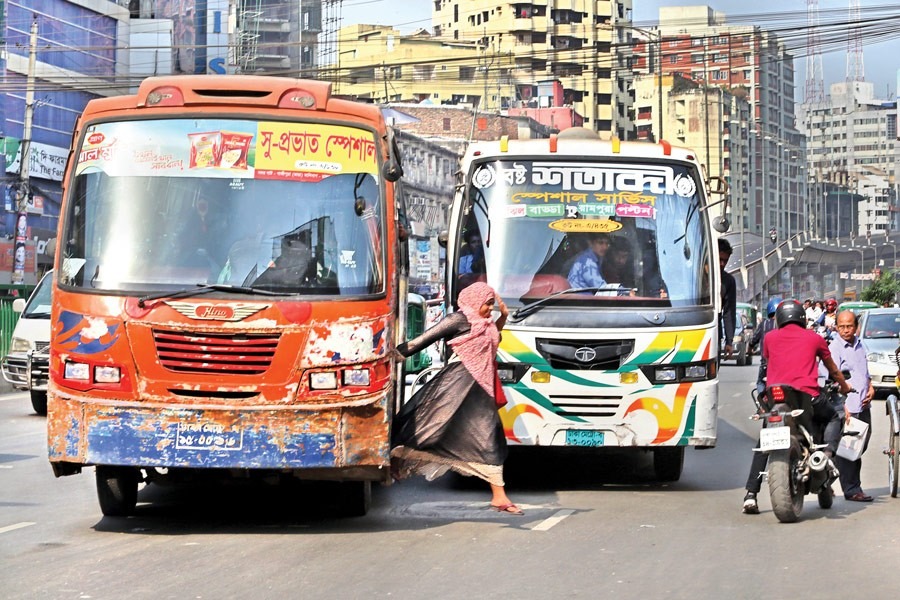
Published :
Updated :

The proliferation of motorcycles, driven by various incentives for mobility, has made them a popular alternative to public transport. In the first seven months of this year, a staggering 153,468 new motorcycles were registered across the country, with Dhaka alone accounting for 36 per cent. This figure, however, does not account for unregistered motorbikes, suggesting that the actual figure is even higher.
Unlike motorcycles, there is no formal registration system for battery-run rickshaws, making it impossible to determine their actual numbers. The streets of Dhaka are inundated with these vehicles, contributing to the daily congestion in various parts of the city. The demand for these motorized vehicles is on the rise, as they offer commuters a faster and more convenient mode of transportation.
Unfortunately, battery-run rickshaw drivers have also adopted the habit of driving on the wrong side of the road, mirroring the behaviour of motorcyclists. Many of these drivers are known for their lack of respect for others, with some even being involved in criminal activities such as drug addiction, mugging, and snatching.
Again, a number of these drivers fled from their home districts, towns and villages and came to Dhaka as they were involved with the political party in power before August 5 last year. As the July mass uprising toppled the autocratic regime of Hasina a year back, leaders and activists of the Bangladesh Awami League (BAL) came under retaliatory attack by those who were previously intimidated by them for their involvement with opposition parties.
Regular commuters have already experienced the carelessness and arrogance of a section of battery-run rickshaw drivers who drive on the wrong side whenever they get the chance. It becomes impossible to resist them, and attempting to do so brings a mob. Even in many cases, traffic police appear helpless and allow them to drive on the wrong side.
Nevertheless, a lack of adequate and decent jobs in semi-urban and rural areas has also driven many to become battery-run rickshaw pullers and migrate to Dhaka and major cities. So, the influx of these vehicles is linked to the unemployment problem in the country. Another factor is the absence of an efficient public transport system in the country. Except for the metro-rail in Dhaka, the bus-based public transport is inefficient and hazardous. It is disappointing to find that hundreds of dirty and ramshackle buses mark the capital city of Bangladesh, which are continuously polluting the air and causing noise. It is a nightmare for the commuters to travel by these buses, where the seats are congested and the windows are broken.
Due to a rise in motorcycles and battery-rickshaws, roads and streets in most parts of Dhaka witness gridlock. So, a large number of motor bikers and rickshaw pullers often seek shortcuts on overcrowded roads to save time. By doing so, they disrupt normal traffic flow, amplifying the risk of accidents.
Despite reckless wrong-side driving, the number of accidents is relatively low in Dhaka, mainly due to an extra cautionary approach taken by private cars, CNG-driven auto rickshaws and buses to provide room for the motorbikes or battery-run rickshaws coming from the opposite side in wrong lanes. However, it's important to note that even a small number of accidents can have severe consequences. The violators, however, do not understand that they not only endanger their own lives but also the lives of pedestrians and others driving on the right side of the road. Instead, they show a blatant disregard for the law and public safety norms. The near-absence of the fear of prosecution also turns them desperate. They are desperate to take shortcuts, and it doesn't matter whether the roads are broad, narrow, or arterial stretches.
So far, no effective measures have been taken to curb the bad culture of wrong-side driving. Many see a shortcut as a good way to save time, and so they take it, violating the law, without thinking of the consequences. And this is a traffic problem that cannot be solved by design changes alone. It needs strict and consistent enforcement of laws at various levels along with ensuring an efficient public transport and building a greater public awareness.
asjadulk@gmail.com


 For all latest news, follow The Financial Express Google News channel.
For all latest news, follow The Financial Express Google News channel.